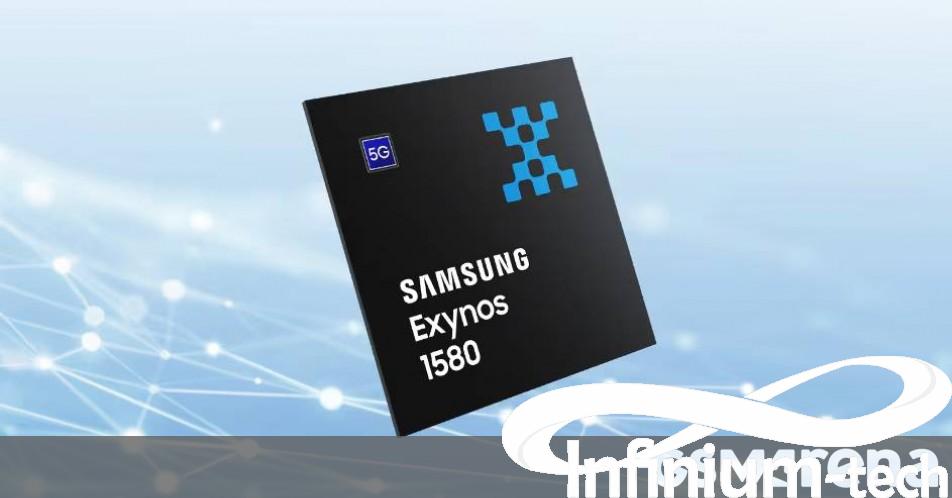Exynos 1580 unveiled with Cortex-A720 cores, double the GPU hardware | Infinium-tech
The Exynos 1480 was a great mid-range chip – in fact, its sustained performance was very good. But it was only used in one phone, Samsung’s own Galaxy A55, which is a bit of a shame. Here’s what comes next – the Exynos 1580, likely to be used in the upcoming Galaxy A56.
This chip is a major upgrade over its predecessor – it’s built on a new node with ARMv9 CPU cores and dual GPU hardware. Specifically, the chip is built on Samsung’s third-generation 4nm EUV FinFET process.

The CPU of the Exynos 1580 goes in a three-cluster design with one prime Cortex-A720 core (2.9GHz), three larger A720 cores (2.6GHz) and four A520 (1.95GHz). This alone provides a major performance boost compared to the 1480, which used ARMv8 cores.
The GPU is based on AMD’s RDNA 3 architecture, which now includes two work group processors – up from just one on the 1480 (the Exynos 2400 has six). Samsung says maximum performance is up 37% while performance at the same power level as the 1480 is up 20%. It also boosts the GPU GL2 cache.
The NPU delivers 14.7 TOPS performance. The 1380 only had 4.9 tops, while the 1480 went up…Samsung doesn’t say. However, both the 1480 and 1580 NPUs are described as “6K Macs”, so there’s probably no difference. The spec sheet says that the new NPU has an increased cache capacity of 2 MB, but its impact will be known only after benchmarks.
The new chip supports LPDDR5 RAM and UFS 3.1 storage. Connectivity is mostly the same with 5G (both sub-6GHz and mmWave), Wi-Fi 6E (ax), and Bluetooth 5.4. There is no AV1 decoder.
Display and camera support remains the same as before, with up to 1080p+ at 144Hz and 4K video at 60fps, along with a single 200MP camera (or dual 32+32MP @ 30fps). A 200MP camera on the Galaxy A56 sounds impossible, but Samsung says the new chip has improved image processing over its predecessor.
As we mentioned above, the Exynos 1580 is likely to be used in Samsung’s Galaxy A56, which is expected to be unveiled early next year (although, we’re already seeing benchmarks of it). It could also be featured in tablets, for example the 2023 Galaxy Tab S9 FE(+) uses the Exynos 1380, but that’s just a guess at this point.
| exynos 1480 | exynos 1580 | |
|---|---|---|
| node | 4nm euv | 4nm euv |
| cpu(prime) | , | 1x Cortex-A720 @ 2.9GHz |
| CPU (large) | 4x Cortex-A78 @ 2.75GHz | 3x Cortex-A720 @ 2.6GHz |
| CPU (small) | 4x Cortex-A55 @ 2.0GHz | 4x Cortex-A520 @ 1.95GHzCortex-A520 @ 1.95Ghz |
| gpu | xclipse 530 RDNA 3, 1x WGP |
xclipse 540 RDNA 3, 2x WGP |
| npu | 6K Mac | 6K Mac (14.7 TOPS) |
| to hit | LPDDR4X, LPDDR5 | LPDDR5 |
| storage | UFS 3.1 | UFS 3.1 |
| Screen | 1080p+ @ 144Hz | 1080p+ @ 144Hz |
| camera | 200MP, 4K @ 60fps | 200MP, 4K @ 60fps |
| 5g | NR (5.1Gbps down, 1.28Gbps up) mmWave (4.84Gbps down, 0.92Gbps up) |
NR (5.1Gbps down, 1.28Gbps up) mmWave (4.84Gbps down, 0.92Gbps up) |
| 4g | Cat. 18(6CC 1.2Gbps below, 2CC 211Mbps above) | Cat. 18(6CC 1.2Gbps below, 2CC 211Mbps above) |
| wifi | Wi-Fi 6E | Wi-Fi 6E |
| Bluetooth | 5.3 | 5.4 |

















Leave a Reply